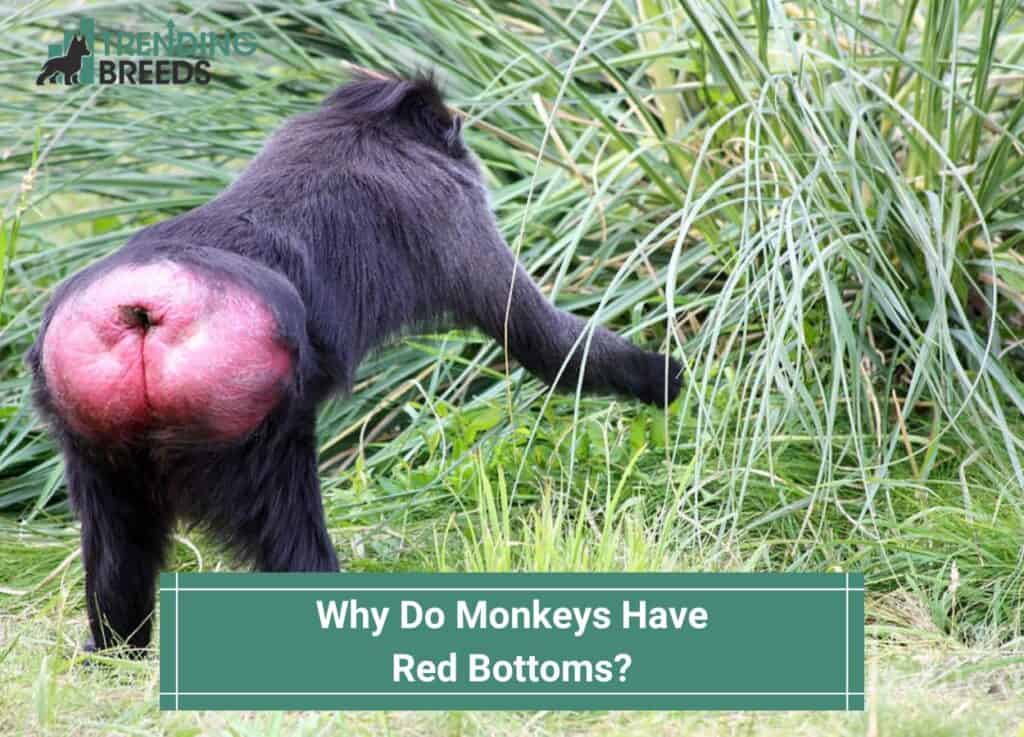
When visiting a zoo, have you ever seen any monkeys with red bottoms? That could have surprised you if you weren’t familiar with these primates. You might wonder–or your child might wonder–why do monkeys have red bottoms?
Why are monkey butts red? Just to be clear, only female monkeys experience the enlarged red bottom. Therefore, yes, it’s about sex; it indicates that they’re fertile in their mating cycle.
Continue reading to learn more about these red-butt monkeys.
Other articles you would like: Why Do Puppies Eat Their Poop and Why Dogs Like To Sleep With Their Owners.
Table of Contents
What Causes Red Bottoms in Baboons?
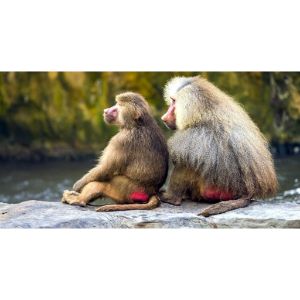
The most discussed species of monkeys with red bottoms are baboons. So, for this article, we will discuss baboons in particular. Besides, the reasoning behind the red bottoms is the same for all monkey species.
Baboons are well known for having red bottoms, which are a mating signal. Yes, the colorful buttocks that distinguish these monkeys signify fertility. Red bottoms are only found on female baboons.
Baboon male buttocks may be reddish, but they are never completely red. But female baboon bottoms are not usually red, either. Rather, the stage of the female baboon’s fertilization cycle may be indicated by the color of her butt.
The swelling and reddening of a female baboon’s bottom often indicate that she is fertile and prepared for mating.
The baboon’s bottoms get red and expand by four to ten inches (approximately 10 to over 25 cm), highlighting their buttocks even more.
What Purposes Do a Baboon’s Red Bottoms Serve?
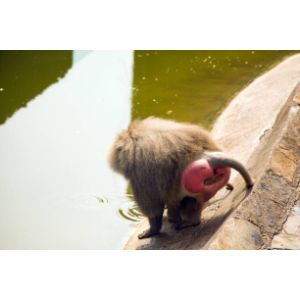
While the crimson bottoms are undoubtedly entertaining, this distinctive derriere also has other uses. These buttocks have several important yet underappreciated roles in the lives of baboons.
Indicator of Fertility
As previously described, a female baboon’s butt will turn red as an indication of her fertility. Once a month, this phenomenon lasts for around 10 to 20 days each time.
The male baboons recognize a female baboon as being at a certain stage of her monthly cycle and biologically prepared to procreate when her butt expands and starts to appear noticeably red.
A female baboon’s body could be prepared for pregnancy, but she might not always be open to mating attempts, particularly if she has recently given birth.
Most baboons typically pause for about a year to concentrate on raising their young. Multiple cycles can occur during this period, but no reproduction offers will be sent to the female, despite her bottom appearing red and swollen.
Misconceptions About Why Monkeys Have Red Bottoms
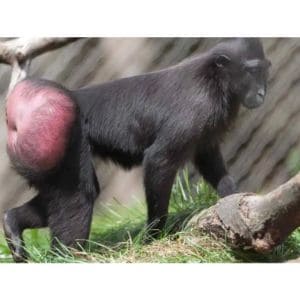
Monkeys were thought to have red bottoms for many reasons. The two most popular yet disproven theories are that they serve as an indicator of these concepts.
Probability of Conception and Infant Survival
It was originally thought that a female baboon’s buttocks would affect her capacity to reproduce and effectively rear her offspring through infancy—the larger and redder the buttocks, the healthier the offspring.
Furthermore, it was thought that females with larger buttocks would mate sooner and be able to have more offspring, all of whom would have a greater chance of surviving than those with smaller buttocks.
However, recent research from 2015 has demonstrated that this may be untrue. Various circumstances influence the female’s capacity to conceive and effectively raise her children. These include troop levels, postpartum cycles, and other things.
The size or volume of swelling in a female baboon’s bottom throughout her reproductive phase is no longer considered a reliable predictor of successful conception and young baboon survival.
An Indicator of Attractiveness
Another long-held notion regarding baboon buttocks is that male baboons are more drawn to females with larger and more colorful bottoms.
The male members of this monkey group thought that the size and color of the female baboons’ buttocks acted as an aphrodisiac and a yardstick by which they judged the desirability of a possible partner.
Recent research has disproved this hypothesis, demonstrating that male baboons chose to mate with mothers who had undergone more postpartum cycles.
The same study contends that males would keep track of females’ post-partum cycles and refrain from approaching them for a sexual encounter if they believe it is “too soon.”
What Causes the Red Bottom of a Baboon?
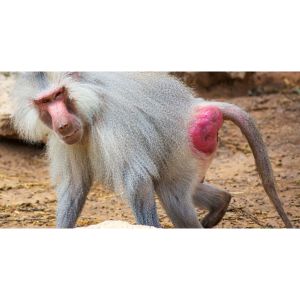
Because of the blood and bodily fluid retention brought on by sexual swelling, a female baboon’s butt expands and becomes red.
The female baboon may undergo sexual swelling during the 37th day of its fertility cycle, which causes blood, water, and other bodily fluids to be stored in the baboon’s procreative body parts.
Because of this fluid storage, baboons are notorious for having flushed red bottoms. The baboon’s bottom likewise swells to a size that is noticeably greater than normal due to this phenomenon.
The female baboon’s bottom diminishes and returns to its regular pigmentation after this phase of the reproductive cycle has passed.
Can a Baboon Make Her Bottom Red Willingly?

While a baboon’s bottom reddening and swelling are typically regulated by the monkey’s reproductive cycle, there are a few unusual instances in which a baboon may activate this process as a means of self-defense or survival.
One of the key objectives of each new dominant male in the group is to dominate the female population by mating with them.
To ensure that the prior dominant male’s genes continue to control the following generation, it is frequently in their best interests to murder any offspring he may have produced.
Some of them may even go to the extent of inducing miscarriage in expectant baboons.
Some female baboons may expand their buttocks and look red to fake fertility to allow the male to mate with them and stop the male from murdering their offspring. This is done to safeguard their young and unborn babies.
Other Monkeys with Red Bottoms
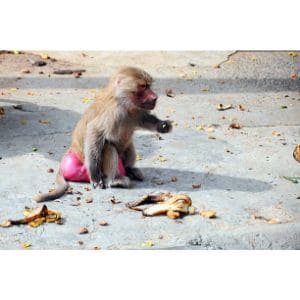
Here are some other monkeys that have red bottoms:
Chimpanzees
Chimpanzees lack tails. They are not quite monkeys, but apes–humans are also considered apes. The amount and form of a chimpanzee’s buttock swelling vary.
A red and swollen bottom, like in many female primates, signifies an ovulating and fertile female seeking a mate; this is a non-verbal manner for the female chimp to express her sexual desires to the male chimp whenever she is in heat.
The fact that chimpanzees are adept at identifying rear ends in the same manner humans are at identifying faces is more evidence that buttocks are exceptional in a chimpanzee’s world (albeit they can also recall faces).
They can identify buttocks because they know it is time to mate when their females get red, swollen bottoms. A chimp can also identify a person’s kin, allies, or enemies and their state of health.
Mandrils
Baboons and mandrils have similar physical makeup, except that a baboon has a prehensile tail, whereas a mandril has a stubby tail. A separate kind of monkey called a mandril is found in Africa.
Female mandrils, which develop a swollen red butt once ready for mating, exhibit a more colorful buttock than the dominant male mandrils.
Since their testosterone levels rise when they triumph in a struggle to become leaders, the high-ranking males also sport more colorful buttocks than other guys in the group. Female baboons are especially attracted to these vibrant males.
Japanese Macaques
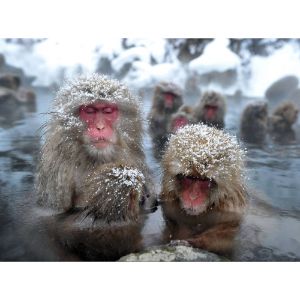
The crimson cheeks and matching red butts of the Japanese macaque, sometimes known as the snow monkey, make them stick out.
Like many other monkeys on this list, the females have redder bottoms than the males. They are alluring to men because of their crimson bottoms.
Rhesus Macaques
Old-world monkeys like the Rhesus macaque, sometimes called Mavava Mulatta, frequently remain on the land. Red behinds and red coloring on their face and genitalia are characteristics of both male and female Rhesus macaques.
All macaques find red skin to be sexually attractive overall. The females favor male macaques with redder buttocks. According to experts, when a female Rhesus Macaque’s butt is big and red, she may have a better chance of meeting a mate.
Celebes Crested Macaques
The Crested Black Macaque is another name for the Celebes crested macaque. The female signals it is ready for mating by displaying an abnormally inflated rear end.
The reddest and most stunning butt among primates belongs to these monkeys. When in heat, the female butt swells greatly and turns an extremely bright red, but on normal days, the male Celebes has a far redder butt.
Frequently Asked Questions
Why do some monkeys have hairless bottoms?
Baboons tend to sit on their rear ends, This means that they don’t need hair but instead have hairless pads of calloused skin instead.
Why can’t you smile at gorillas?
Gorillas perceive the baring of teeth as a threat, not a smile. Smiling at them will be construed as a challenge.
What happens if you look a monkey in the eye?
Most monkeys view direct eye contact as a challenge. In zoos this may not matter, but in the wild it is not recommended.
So Why Do Monkeys Have Red Bottoms?
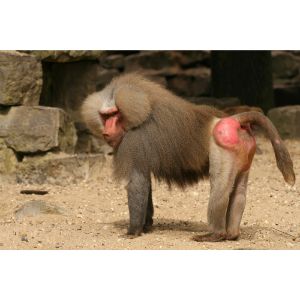
Most people would think that the monkey’s red bottoms are merely a particular physical characteristic. But in reality, it serves a very important social purpose in the baboons’ habitat.
The baboon’s distinctive red bottoms play a crucial role in these monkeys’ mating systems. Additionally, they can be used as a preservation strategy to protect the lives of their youngest, most helpless members.
You will also like:
- Why Dogs Like To Sleep Underneath The Bed?
- Why Do Dogs Bite Each Other On The Neck?
- Why Do Dogs Age So Fast?
If you want to learn more about monkeys check out “20 INTERESTING FACT ABOUT MONKEY” down below:




